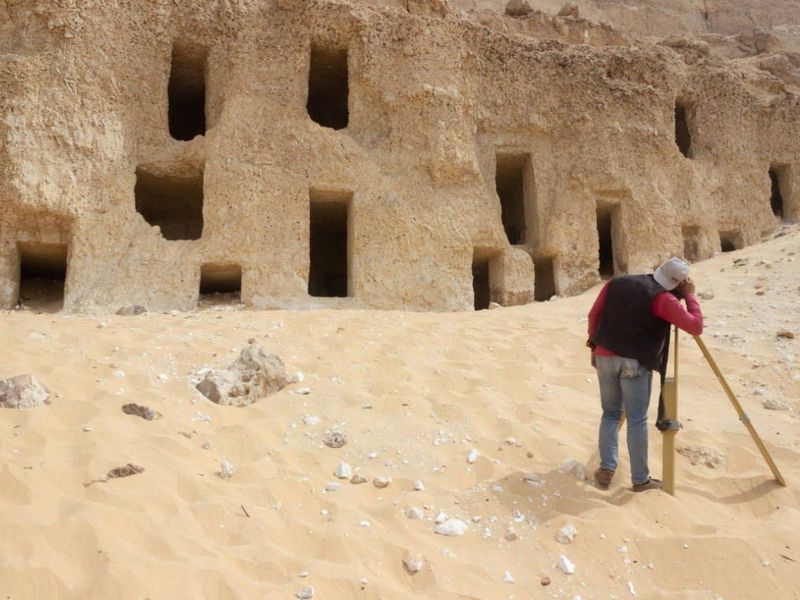Egyptian Archaeologists Accidentally Discover 250 Ancient, Rock-Cut Tombs

An archaeological survey crew accidentally discovered some 250 rock-cut tombs at the Al-Hamidiyah necropolis near Sohag, Egypt. The graves range in age from the end of the Old Kingdom around 2200 B.C. to the end of the Ptolemaic period in 30 B.C., according to Nevine El-Aref of Ahram Online.
Several styles of tombs and burial wells are carved into different levels of a mountain face at the site, says Mustafa Waziri, secretary-general of the Supreme Council of Antiquities, in a statement from the Egyptian Ministry of Tourism and Antiquities. The necropolis is located in southern Egypt, on the West Bank of the Nile River.
One of the burials includes a sloping tomb with a false door and a hallway leading to a gallery with a shaft. The door is inscribed with hieroglyphs depicting the resident of the tomb slaughtering sacrifices while mourners make offerings to the deceased.
“Given their small size compared with the tombs reserved for royalty, which are of large sizes, these tombs may have been allocated to the common people,” historian Bassam al-Shamaa tells Ahmed Gomaa of Al-Monitor. “This provides more details about the daily life of ordinary people at the time.”
Archaeologists conducting excavation work at the necropolis discovered numerous pottery shards and intact pots. Some of the pieces were used in daily life, while others, known as votive miniatures, were crafted for funerary purposes, says Mohamed Abdel-Badiaa, head of the Central Department of Antiquities for Upper Egypt, in the statement.
The team also found remnants of a round metal mirror, human and animal bones, small alabaster pots, amphorae fragments dated to Egypt’s Late Period (c. 664 to 332 B.C.), and pieces of limestone funerary plates dated to the Sixth Dynasty (c. 2345 to 2181 B.C.).
Badiaa and his colleagues expect to find more rock-cut tombs at the site as excavations continue. Per the statement, they have already documented more than 300 tombs in the area, which was centrally located near the ancient cities of Aswan and Abido.
Use of the burial site spans more than 2,000 years, beginning in the Old Kingdom period, which included Pharaoh Khufu, builder of the Great Pyramid of Giza. The last interments likely occurred around the time of Cleopatra’s death in 30 B.C., which marked the end of the Ptolemaic dynasty.
The Al-Hamidiyah necropolis is believed to have been the final resting place for leaders and officials of the city of Akhmim, one of the most important administrative centers in ancient Egypt, reports Jesse Holth for ARTnews. Akhmim was home to the cult of Min, a god of fertility and sexuality who was also associated with the desert, according to Ancient Egypt Online.
Finds made at the site may pave the way for future discoveries at oft-overlooked archaeological sites, Badiaa tells Al-Monitor.
“Egypt has many antiquities sites, but light must be shed on other unknown areas,” he adds. “[Excavations] should not be limited to famous archaeological areas such as Saqqara or Luxor.”
Source: The Smithsonian Magazine




